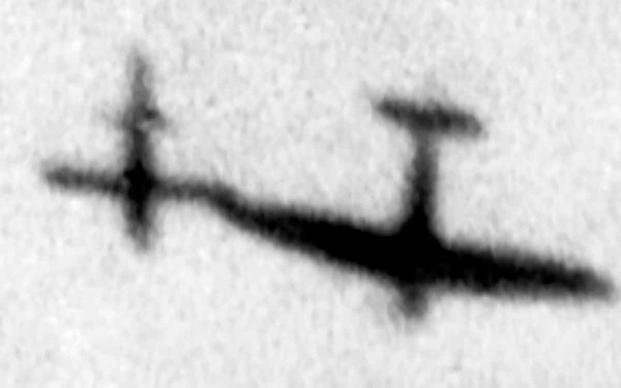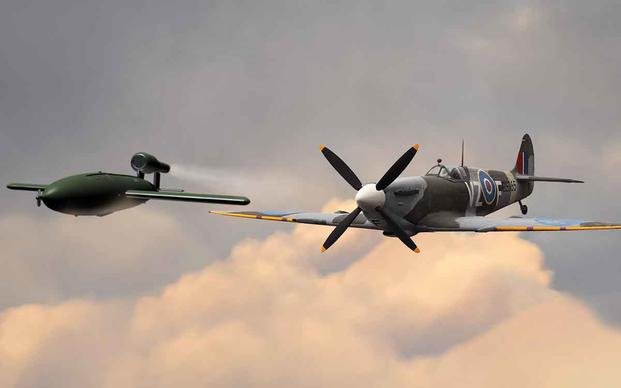On June 13, 1944, the citizens of London awoke to an eerie but puzzling buzz approaching the city. The morning stillness was shattered when the buzzing stopped and a strange aircraft plummeted from the sky, hitting a railway bridge and unleashing 1,800 pounds of explosive force. The bizarre aircraft was a German-made Vergeltungswaffen (“vengeance weapon”) — now known as the V1 Flying Bomb.
It was the first-ever use of a cruise missile in human warfare and the first of some 20,000 V1 bombs that would be launched at Allied targets between June 1944 and March 1945. The V1 wasn’t an accurate weapon, but it didn’t have to be; filled with nearly one ton of high explosives, the weapon was designed to sow fear into Allied civilians and undermine morale.
The best way to prevent the launch of a V1 was, of course, to cripple Adolf Hitler’s ability to build and fire them in the first place, and the U.S. Army Air Force and British Royal Air Force’s Bomber Command became so effective at destroying German V1 facilities that the Nazis’ entire flying bomb construction operation had to be moved underground. But once the weapons were airborne, RAF pilots found another way to bring them down: tipping their wings.
Nicknamed “buzz bombs” because of the distinctive sound of their pulsejet engines, the V1 created the drain on morale their Nazi creators intended. Combined with the incredible destructive force for which they became known, the weapon’s incoming noise was perfect for creating tension and fear among Allied civilians in densely populated urban centers. Though they had an operational range of about 150 miles, they could be launched from ground-based firing tubes, catapult ramps or even midair from Heinkel He 111 bombers.
Despite its advantages, the V1’s weakness was in altitude and targeting. A V1 bomb had about a half-hour of flight time, at the end of which it would plummet to earth and unleash the power of its high explosive warhead. It was not a precise weapon: Its guidance system was preset before launch and used a series of gyroscopes as a kind of automatic pilot. Once airborne, it cruised between two thousand and three thousand feet at a speed of around 340-400 mph.
An incoming V1 could be intercepted by radar-supported, anti-aircraft artillery, or it could be caught up by the many barrage balloons defending London from incoming bombers and fighters. Hitting one with anti-aircraft fire was very difficult, however, and there was no guarantee that they would fly into the support cables of a barrage balloon.
What was even more ideal was destroying the V1s before they ever reached populated areas, and that meant intercepting them midflight. The RAF’s workhorse, the Supermarine Spitfire, could reach the necessary altitude within a minute after takeoff, and with a top speed of 370 mph, it was capable of intercepting an incoming flying bomb as long as it approached from a dive of at least 5,000 feet.
Shooting down a missile packed with TNT and ammonium nitrate usually meant that pilots had to get uncomfortably close to get a hit — and that came with the risk of setting off the massive bomb inside. In cases where shooting down one of these Nazi-built cruise missiles failed or wasn’t possible, RAF pilots devised a way to bring them down that soon became the stuff of legend: touching the wingtips of their fighter to bump a one-ton flying bomb out of the sky.
As a last resort, the RAF’s most skilled Spitfire pilots could fly as close as possible to a V1 bomb midflight with the goal of touching their aircraft’s wing to the wing of the V1, then tipping it. This would throw off the bomb’s internal series of gyros, turn the craft into a nosedive and force it into the ground (or, better yet, the English Channel) while flying at its top speed.
Today’s RAF insists that pilots, skilled as they were, did not need to actually touch the tips of their wings, but instead disrupted the airflow to the bomb’s pulsejet engine to throw the V1 off course. Some pilots, however, really did touch their wings.
“Some pilots would have touched the wing — the different air pressure at the tip of the aircraft would be enough to cause a disturbance in the aerodynamics around the wing which is then enough to knock it off course, disrupt the gyroscopes and then get the aircraft crash into the ground,” Wing Commander Nick Robson of the RAF told the UK’s Forces News in 2019.

“That’s all it needed to do to disrupt the flightpath, just slightly, and either by physically hitting the wing, or actually it takes more skill, to put the wing so close that the vortexes at the wingtip disturb the air around the V1 wing itself, causing it to go off course.”
The tactic was daring, but ultimately necessary. Each V1 to hit a target killed an estimated 38 people, according to the Imperial War Museum. Most flying bombs were targeted at London or the port city of Antwerp, Belgium, but other cities saw attacks as the war progressed. The number killed by V1 attacks ranges as high as 6,000, with another 18,000 wounded.
Want to Learn More About Military Life?
Whether you’re thinking of joining the military, looking for post-military careers or keeping up with military life and benefits, Military.com has you covered. Subscribe to Military.com to have military news, updates and resources delivered directly to your inbox.
Story Continues
Read the full article here


